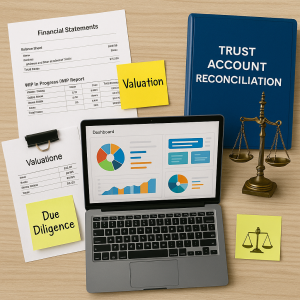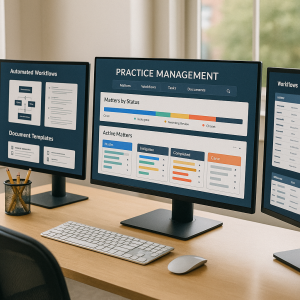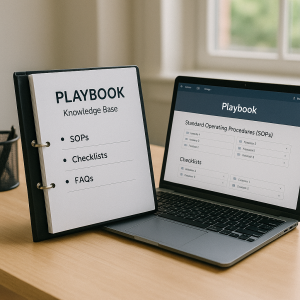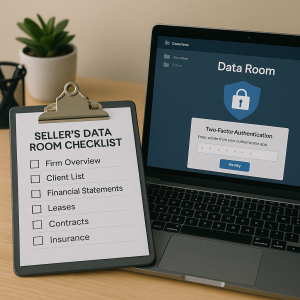The main exit paths
-
Orderly wind‑down
Stop new intake, finish active matters, close trust accounts, archive files, and dissolve the entity. -
Micro‑practice glide path
Move to a limited, part‑time caseload. This can be a good bridge to retirement and lets you mentor successor counsel. -
Sale of the practice or a practice area
You transfer goodwill, systems, active matters with client consent, and often agree to a transition period. Most U.S. jurisdictions permit this with conditions under versions of Model Rule 1.17, including written client notice and no fee increase solely due to the sale. American Bar Association -
Merger into a larger firm or “of counsel” transition
You fold in, hand over operations, and often receive a negotiated earn‑out. This can be faster than a retail sale.
No single path is right for everyone. If your goal is to maximize value and protect clients, a prepared sale or merger usually beats a last‑minute wind‑down.
What buyers actually pay for
 A buyer values what will keep working the day after you leave.
A buyer values what will keep working the day after you leave.
-
Clean financials. Three years of accrual‑basis financials, AR aging with notes on collectability, WIP reports, and trust reconciliations.
-
Predictable revenue. Recurring work or steady referral sources.
-
A credible brand. Reviews, a functioning website, and referral agreements that can be assigned or replicated.
-
Documented systems. Intake, conflicts, calendaring, billing, trust accounting, document creation, template libraries, and quality control.
-
Transferable knowledge. Checklists, playbooks, and matter‑type workflows that a competent lawyer can follow.
-
Stable people and vendors. Cross‑trained staff, clear job descriptions, and assignable technology and lease contracts.
-
Risk under control. Malpractice history, active dockets with known deadlines, and clear file retention policies. Post‑sale overlap time is often expected and ethically permitted when done correctly. The ABA has said a reasonable period after closing to aid the transition is appropriate. ABA Journal
Ethics and risk checkpoints you cannot skip
-
 Client choice and notice. Model Rule 1.17 requires written notice to each client with the chance to choose other counsel or take possession of the file. The rule prohibits raising fees due to the sale alone. Many states track this framework, but details vary. Check your jurisdiction’s version. American Bar Association
Client choice and notice. Model Rule 1.17 requires written notice to each client with the chance to choose other counsel or take possession of the file. The rule prohibits raising fees due to the sale alone. Many states track this framework, but details vary. Check your jurisdiction’s version. American Bar Association -
Malpractice “tail” coverage. Most legal malpractice policies are claims‑made. If a claim arrives after your policy ends, there is no coverage unless you purchase an Extended Reporting Endorsement, commonly called tail coverage. You attach it to your final policy and it lets you report post‑retirement claims. ALPS Insurance
-
You still have exposure. Selling the practice does not erase liability for work performed before the sale. Plan tail coverage and release language accordingly. lawyersmutualnc.com
-
Confidentiality and conflicts. Share only what is necessary in a pre‑sale data room and use NDAs. Do conflict checks before any client transfer.
-
Trust accounting. Reconcile monthly, document any transfers, and confirm instructions for outstanding retainers and third‑party funds before closing.
-
Entire practice or entire practice area. Many jurisdictions require you to sell an entire practice or an entire practice area, not cherry‑pick only the top matters. American Bar Association
For a simple, state‑bar‑style roadmap, see checklists like the NC Bar’s “Checklist for Selling a Law Practice.” Treat it as a template and adapt to your jurisdiction. North Carolina Bar Association
Make your practice “plug‑and‑play”
 The fastest way to lift value is to capture the way you practice into systems that others can run. A modern practice management platform is your backbone. Configure it so a buyer can open the hood and see a single, coherent engine.
The fastest way to lift value is to capture the way you practice into systems that others can run. A modern practice management platform is your backbone. Configure it so a buyer can open the hood and see a single, coherent engine.
Unify matter information
-
Standard naming convention for matters and files.
-
Custom fields for facts you always ask in intake.
-
One place for deadlines, notes, tasks, contacts, and documents.
Build workflows people can follow
-
Stage pipelines for each matter type. Example: Intake, Investigation, Pleadings, Discovery, Negotiation, Resolution.
-
Task checklists with owners, due dates, dependencies, and quality gates.
-
Automated reminders for court rules and limitation periods.
-
Pre‑built email and letter templates for each stage, including client updates.
Streamline document production
-
Intelligent templates with variables for party names, dates, case numbers, venue, and common clauses.
-
Clause library with commentary explaining when and why to use each variation.
-
Version control and a clear approval path.
Tighten timekeeping and billing
-
Default task codes, easy timers, and draft invoice workflows.
-
Trust‑to‑billing rules that prevent accidental commingling.
-
AR dashboards with responsible attorney assignments.
Measure what matters
-
Dashboards for cycle time by matter type, realization and collection rates, referral source performance, and deadline compliance.
-
Monthly one‑page scorecard a buyer can trust.
Security and continuity
-
Role‑based access, MFA, password vault, vendor and license inventory, and a disaster recovery plan. Buyers prefer firms that can demonstrate this on paper.
Build your “playbook” knowledge base
 Create a searchable folder or wiki. Give buyers the instructions to run the shop.
Create a searchable folder or wiki. Give buyers the instructions to run the shop.
-
Intake script and decision trees for matter triage.
-
Conflicts process with screenshots.
-
Docketing and critical date rules.
-
How‑to guides for your top five document types.
-
Style guide for filings and correspondence.
-
Settlement checklists, lien resolution steps, and closing procedures.
-
Vendor list with contacts and contract terms.
-
Marketing and referral processes with sample outreach.
-
File retention matrix and destruction policy.
A well written playbook is the difference between buying a job and buying a business.
A practical 12‑month prep timeline
Months 12 to 9
- Pick a target date.
- Clean financials and reconcile trust.
- Choose or overhaul your practice management system.
- Draft your SOP table of contents and start with intake, conflicts, and calendaring.
Months 9 to 6
- Finish top workflows and document templates.
- Build a secure data room: financials, WIP, AR, matter list, vendor contracts, lease, insurance, sample pleadings, policies.
- Identify likely successors. Options include a known competitor, a former colleague, a rising associate, or a larger firm seeking a bolt‑on.
Months 6 to 3
- Negotiate an LOI with headline terms: price, payment schedule, treatment of WIP and AR, staff offers, transition services, and non‑solicit.
- Map conflicts.
- Draft client notice letters and a communications plan.
Months 3 to 0
- Send notices and secure consents.
- Migrate data and test access.
- Deliver training. Use ride‑alongs, shadowing on calls, and joint client meetings. ABA ethics guidance recognizes a reasonable transition window. ABA Journal
After closing
-
Run a closing checklist: confirm file transfers, update engagement terms where required, finalize escrow or holdback releases, and bind tail coverage. ALPS Insurance+1
Deal mechanics at a glance
-
Structure. Most small firm deals function like an asset sale of goodwill, systems, and equipment, plus a transition to successor counsel.
-
Price and payout. Common structures combine a base payment with an earn‑out tied to client retention or collected revenues over 12 to 36 months.
-
WIP and AR. Define who owns what at closing and how collections are shared.
-
Staff. Offer letters ready on day one. Cross‑training protects value.
-
Transition services. Spell out the number of training hours, joint meetings, introductions to key referral sources, and availability for questions.
-
Restrictions. Expect jurisdiction‑specific limits on post‑sale practice. Model Rule 1.17 requires you to cease the sold practice in the applicable area or jurisdiction. American Bar Association
Client notice: a simple template you can adapt
Dear [Client Name],
I plan to transfer my [practice area] practice to [Buyer Firm] effective [date]. You may choose to retain [Buyer Firm], select other counsel, or take possession of your file. Your fees will not increase because of this transfer. If you wish to object or request your file, please contact us by [date]. If we do not hear from you, we will presume consent to transfer your file to [Buyer Firm] so your matter continues without interruption.
This mirrors core elements required in many jurisdictions. Always align the content and timing with your state’s rule. American Bar Association
A quick seller’s data room checklist
 Three years of financials and tax returns
Three years of financials and tax returns- WIP, AR aging, and unbilled costs
- Trust account reconciliations and open retainers list
- Matter list with stage, key dates, and risks
- Standard engagement letters and fee schedules
- Staff roster, roles, and compensation
- Vendor contracts and license keys
- Templates and SOPs
- Docketing reports and limitation calendars
- Insurance policies and claims history
- Marketing metrics and referral agreements
- File retention and destruction policies
- Cybersecurity policies and access logs
For structure ideas, state bar checklists are helpful starting points. North Carolina Bar Association
 Final thought
Final thought
You built a practice by accumulating expertise. You sell a practice by documenting that expertise so others can deliver it. Capture your workflows, tighten your technology, and plan a thoughtful transition. That is how you protect clients, honor your reputation, and get paid for the business you created.
At 2b1 Inc, we help solo and small-firm lawyers transform their practices into structured, sale-ready businesses. Our team works with you to capture the knowledge that currently lives in your head—or on sticky notes—and build it into a customized practice management system.
By mapping your workflows, automating routine tasks, and centralizing information, you create a practice that runs smoothly without you—making it more attractive to buyers and increasing its final value.
If you’re thinking about your next chapter, let’s make sure your firm is ready for the handoff.
👉415-284-2221 or fill out the form below
Friendly disclaimer
This article is for informational purposes only and is not legal advice. Ethics rules vary by jurisdiction. Consult your state bar and a lawyer experienced in law firm transactions.




